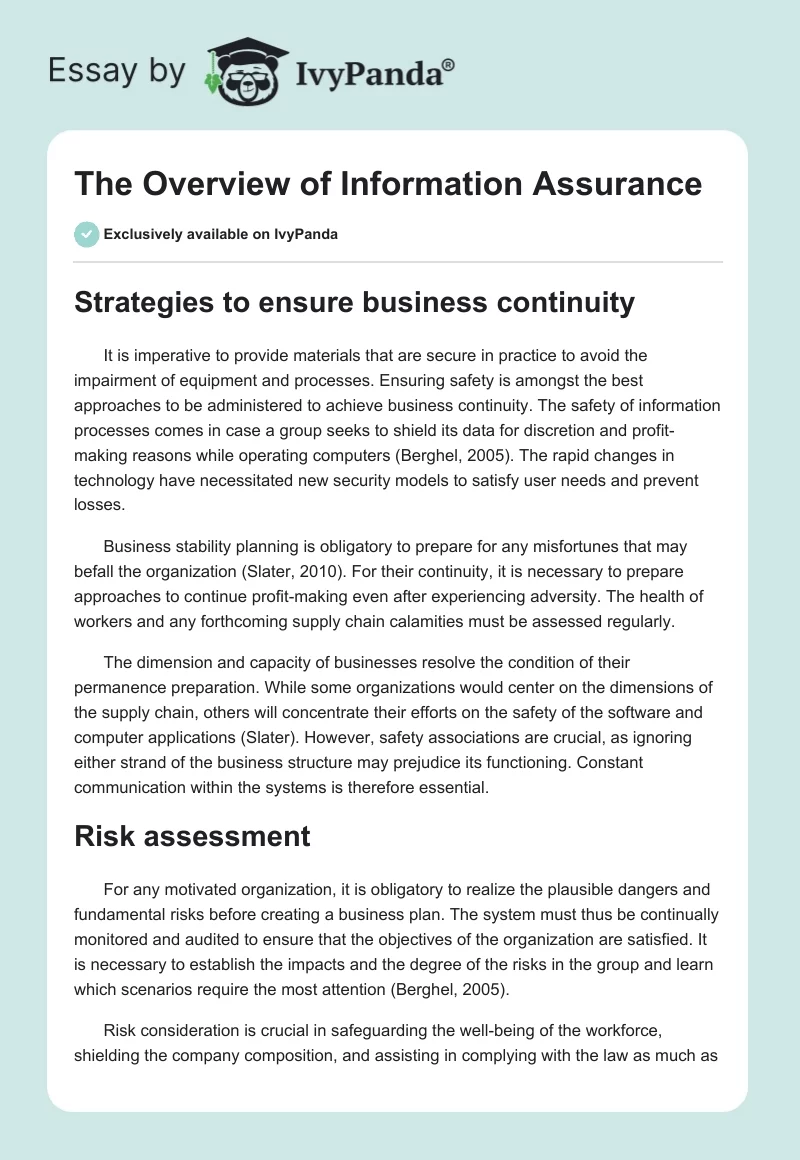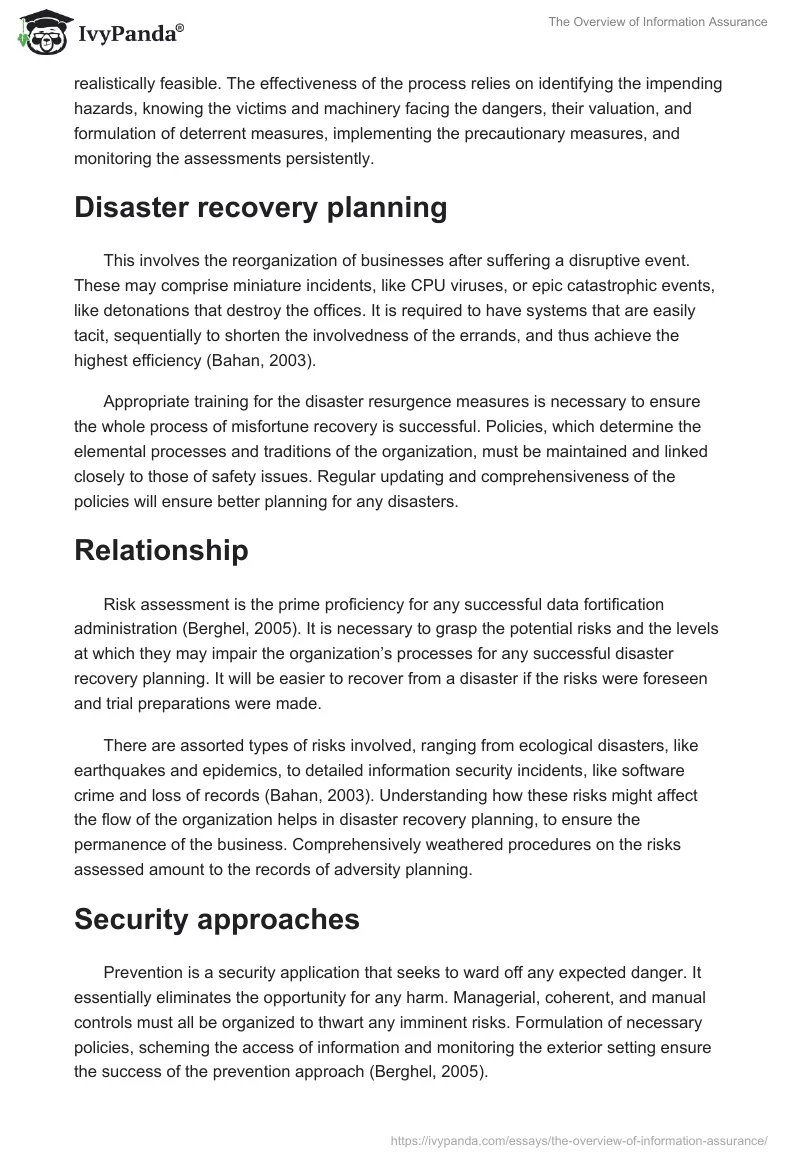Strategies to ensure business continuity
It is imperative to provide materials that are secure in practice to avoid the impairment of equipment and processes. Ensuring safety is amongst the best approaches to be administered to achieve business continuity. The safety of information processes comes in case a group seeks to shield its data for discretion and profit-making reasons while operating computers (Berghel, 2005). The rapid changes in technology have necessitated new security models to satisfy user needs and prevent losses.
Business stability planning is obligatory to prepare for any misfortunes that may befall the organization (Slater, 2010). For their continuity, it is necessary to prepare approaches to continue profit-making even after experiencing adversity. The health of workers and any forthcoming supply chain calamities must be assessed regularly.
The dimension and capacity of businesses resolve the condition of their permanence preparation. While some organizations would center on the dimensions of the supply chain, others will concentrate their efforts on the safety of the software and computer applications (Slater). However, safety associations are crucial, as ignoring either strand of the business structure may prejudice its functioning. Constant communication within the systems is therefore essential.
Risk assessment
For any motivated organization, it is obligatory to realize the plausible dangers and fundamental risks before creating a business plan. The system must thus be continually monitored and audited to ensure that the objectives of the organization are satisfied. It is necessary to establish the impacts and the degree of the risks in the group and learn which scenarios require the most attention (Berghel, 2005).
Risk consideration is crucial in safeguarding the well-being of the workforce, shielding the company composition, and assisting in complying with the law as much as realistically feasible. The effectiveness of the process relies on identifying the impending hazards, knowing the victims and machinery facing the dangers, their valuation, and formulation of deterrent measures, implementing the precautionary measures, and monitoring the assessments persistently.
Disaster recovery planning
This involves the reorganization of businesses after suffering a disruptive event. These may comprise miniature incidents, like CPU viruses, or epic catastrophic events, like detonations that destroy the offices. It is required to have systems that are easily tacit, sequentially to shorten the involvedness of the errands, and thus achieve the highest efficiency (Bahan, 2003).
Appropriate training for the disaster resurgence measures is necessary to ensure the whole process of misfortune recovery is successful. Policies, which determine the elemental processes and traditions of the organization, must be maintained and linked closely to those of safety issues. Regular updating and comprehensiveness of the policies will ensure better planning for any disasters.
Relationship
Risk assessment is the prime proficiency for any successful data fortification administration (Berghel, 2005). It is necessary to grasp the potential risks and the levels at which they may impair the organization’s processes for any successful disaster recovery planning. It will be easier to recover from a disaster if the risks were foreseen and trial preparations were made.
There are assorted types of risks involved, ranging from ecological disasters, like earthquakes and epidemics, to detailed information security incidents, like software crime and loss of records (Bahan, 2003). Understanding how these risks might affect the flow of the organization helps in disaster recovery planning, to ensure the permanence of the business. Comprehensively weathered procedures on the risks assessed amount to the records of adversity planning.
Security approaches
Prevention is a security application that seeks to ward off any expected danger. It essentially eliminates the opportunity for any harm. Managerial, coherent, and manual controls must all be organized to thwart any imminent risks. Formulation of necessary policies, scheming the access of information and monitoring the exterior setting ensure the success of the prevention approach (Berghel, 2005).
Deterrence aims to depress assails by reducing the absorption of attackers on the system, making the system undesirable for those with such a prospect. It involves the decree and some commercial arrangements to dispirit individuals from engaging in the misdeed. The deterrence systems engage in changing the intentions of the would-be offenders.
Admonition involves politely requesting individuals to abide by the existing regulations, even for offenses that do not have punishments. These arrangements strive to apprehend unintended violations, which are not followed. The assumptions of the effectiveness of deterrence are improved through reprimanding. The decline of controls due to augmented expertise and the inhabitant’s growth encourages habitual precautions.
My preferred approach
Prevention is the best practice of civilizing information protection in my opinion. It enables forthcoming offenders to govern their activities with the mission of providing no opportunities for any transgressions. There are several threats, which may neither be deterred nor admonished, for example, terrorist attacks or earthquakes. The expenses on security should thus be planned in a way that any dangers are prevented. Deterring a personage who is willing to lose his life through terrorism activities is exceedingly difficult.
The goal of information assurance is to safeguard the discretion, reliability, and accessibility of the agency’s data related to employees, products, or research studies (Bahan, 2003). Preventing the contact of information to any unofficial individuals and ensuring that it cannot be altered is a decent security application for any organization to set its investments.
References
Bahan, C. (2003). The disaster recovery plan. SANS institute. Web.
Berghel, H. (2005). The two sides of ROI: return on investment vs. risk of incarceration. ACM portal: communications of the ACM, Vol. 48, issue 4.
Slater, D. (2010). Business continuity and disaster recovery planning: the basics. CSO: Security and risks, business continuity. Web.


